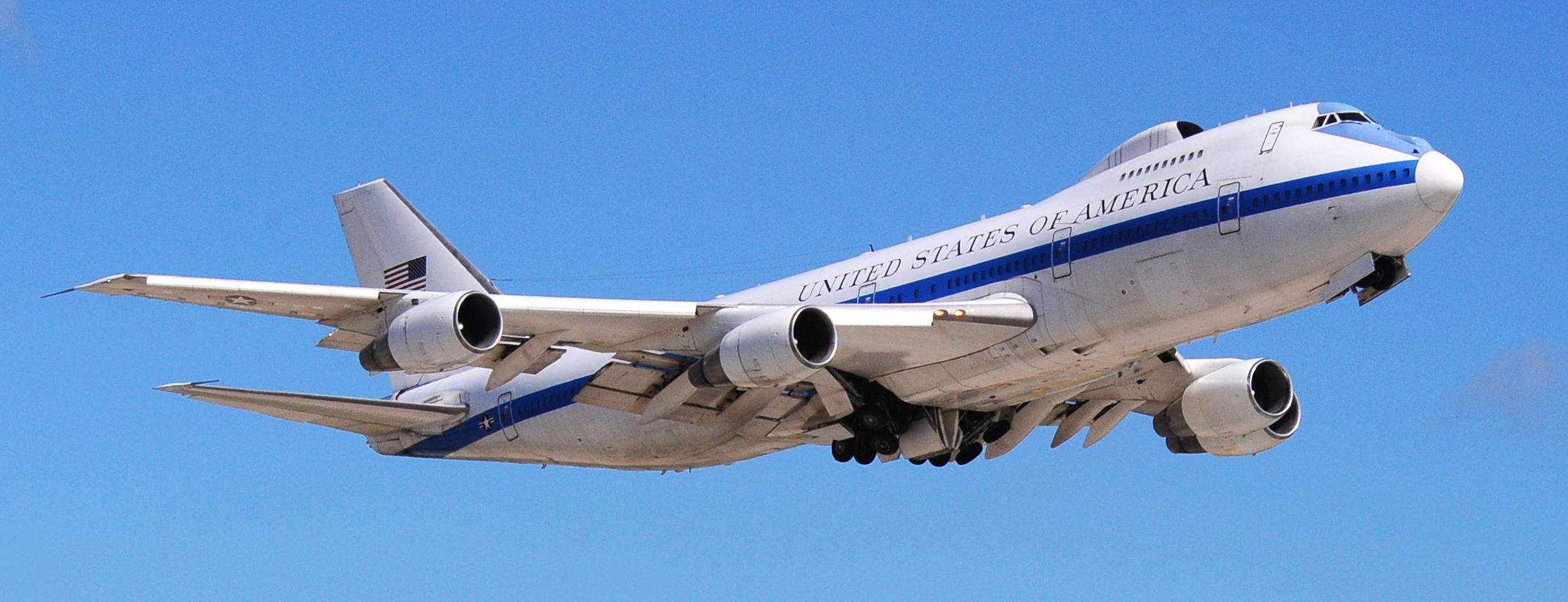The Sierra Nevada Corporation (SNC), a company well known for their extensive modification work of existing aircraft, especially for military applications, has won the $13 billion contract to replace the Air Force’s four aging E-4B “Nightwatch” National Airborne Operations Center (NAOC) jets. These nuclear-hardened aircraft were procured mainly in the 1970s and are based on the almost totally out-of-service 747-200 aircraft. Now SNC has released its first concept images of the E-4B’s successor, and there are some notable features worth discussing.
You can get totally up to date on the Survivable Airborne Operations Center (SAOC) program and SNC’s win in our recent report here. As it stands now, the fleet of SAOC aircraft will eclipse that of the E-4B and could take on the role of another aircraft whose retirement is on the horizon.

First off, we now know for certain what was already largely a given, that the SAOC will be based on the Boeing 747-8, the final production variant of the 747, which is no longer available to be purchased directly from Boeing. The line was shut down in 2022, marking the end of the Jumbo Jet’s long production history. So, these aircraft will have to be acquired second-hand. Just 155 747-8s were built, of which only 55 were in the passenger-carrying 747-8i configuration. This is the same type that is being converted by Boeing for use as the future Air Force One in the VC-25B configuration, which were also acquired second-hand. The four-engine requirement, among others, made the 747 more or less the only aircraft available that could meet the SAOC program’s demands.

The concept art shows the E-4B replacement looking very much like its progenitor, including its iconic white and blue paint scheme. But the 747-8i is larger than its -200 predecessor, with nearly 4,800 square feet of internal space to play with, and features different wings with raked wingtips, as well as more powerful and efficient GEnx high-bypass turbofan engines. It also has the elongated upper deck ‘hump,’ which helps add additional internal square footage over the classic 747-200 configuration, and those that came after, for that matter.

From what we can see in SNC’s concept art, this new variant of the militarized 747-8i features an aerial refueling system, something that, to our knowledge, is still not going to be present on the VC-25B Air Force One jets. This is a major change from their predecessor VC-25As which feature an aerial refueling capability. This has been a controversial move. While this capability is only to be used for emergency circumstances, the fact that the VC-25A can stay aloft far longer than its standard range would allow, even for days at a time, was seen as a critical capability needed during their development at the tail end of the Cold War. Today, E-4Bs are used to train VC-25A crews on aerial refueling.

Of particular note is that the refueling receptacle has been moved from a bulge on the nose, which both the VC-25A and the E-4B share, to atop the hump, just over the cockpit area.

Aerial refueling is used regularly by the E-4Bs, especially for long-range and contingency missions. For instance, the Secretary of Defense often uses the jets to fly around the globe, where multiple aerial refuelings often occur, allowing the aircraft to fly directly without landing to gas up. During a major crisis, keeping the E-4B airborne is key to its survival and ‘business case,’ so it is no surprise that this capability is retained, or at least presented as such in the imagery, even though the 747-8 has substantially better range than its predecessor. Still, the move of the refueling port will change one aspect of the E-4B’s highly recognizable silhouette.

Based on the concept art, one part of the E-4Bs unique profile that won’t change is its iconic satellite communications dome that sits atop the jet’s hump. We see a similar installation in the art even though satellite communications suites have come a long way technologically in the four decades since the E-4B came into being.


Additional satellite communications antenna systems, some of them rectangular in design, are also seen along the spine of the new SAOC concept. The E-4B is basically a flying antenna farm in this area. The VC-25As have been upgraded with broadband satellite communications capability in similar places along their spines.


We also see another new satcom system on the tip of the jet’s upper tail which is similar to other installations on commercial and private aircraft for live satellite television. This would be a critical capability for the Pentagon’s airborne command center, although we can’t say for sure that this is what this installation is for. Regardless, apace-based communications, including leveraging resilient constellations similar to Starlink, will be an increasingly critical part of strategic communications that underpins America’s nuclear deterrent going forward. So, we can expect this aircraft’s spine to be littered with arrays.

The same two bulges for line-of-sight datalink antennas that connect with ground entry points are also seen in the new concept art. These are essential for the jet ‘plugging in’ directly to ground communications sites for secure communications. Also present are the quartet of high frequency (HF) radio ‘stinger’-like antennas on the wingtip’s trailing edges and the horizontal tail’s leading edges.


Additional concept art featured two pods extending out from under the wings, near the wing roots. It is not clear what these were for, but additional communications equipment is one possible reason for them being incorporated in the design among many. Pods like this do not exist on the E-4B. They could also allow for new technologies and mission necessities to be easily integrated on the SAOC in the future.
One feature that appears to be missing is the long trailing wire antennas that are used to communicate with Navy ballistic missile submarines. You can read more about Very Low Frequency trailing wire operations here, but there could be a good reason for these reelable antennas not being present in these concept images that we will address in a moment.
Of course, all of this could change as the program spins up, and especially if requirements change, but as it sits now, this new aircraft will very much be a direct successor to the E-4B, at least visually. Still, one part of all this is worth questioning.
Many of the same features, such as power generation and hardening against electromagnetic pulses from nuclear detonations, as well as some communications and many other sub-systems, will be needed on both the SOAC and the VC-25B. All aspects of this type of development are hugely expensive. How much crossover there is between the two programs, that use the same airframe, is unknown, but it seems wasteful to have the two totally bifurcated. The development of the existing E-4s directly benefitted the VC-25 program decades ago. How much that is the case here, especially considering that two separate contractors are developing separate aircraft configurations, is unknown at this time. In the case of the aerial refueling port, in particular, it seems odd to omit it on the VC-25B when it’s already being developed for the SOAC. Like the unique dichotomy of VC-25A and E-4B that came before it, training for refueling the VC-25B aircraft could occur on the SAOC aircraft.

While we still don’t know much about what the SAOC will end up being capable of, these pieces of concept art help us understand the general configuration that we can expect, at least at this time. We also don’t know if a larger fleet of these aircraft will take over the Looking Glass airborne command post and ground-based ballistic missile launching duties from the Navy’s aging E-6B Mercury. The E-6Bs fill both the Take Charge And Move Out (TACAMO) ballistic missile submarine launch communications and Looking Glass roles today.

The Navy is going to replace the Boeing 707-derived E-6Bs, some of the last 707s ever built, with a new TACAMO aircraft based on the C-130J Super Hercules. While a 747-8i has much higher operating costs and can only access a fraction of the airfields that a C-130J can, it is a far better fit for the wider range of missions the E-4Bs currently execute. This includes acting as an airborne survivable command and control node for the Pentagon’s top leadership and even the President of the United States.

At least for aviation aficionados, the fact that the E-4B, one of the most fascinating and rare aircraft based on the already fan favorite “queen of the skies” 747 will be replaced by the ultimate version of the 747 is certainly exciting. It has to be even more exciting for Nightwatch crews and all the folks that keep these old aircraft in the air. Moving to the best of the type will only increase their capabilities at a time when the strategic peril around the globe is on the rise the likes of which we haven’t seen since the dark days of the Cold War.
As for SNC, there is an absolute mountain of risk and reward riding on this program. It is a huge opportunity for the company as this type of contract was historically a shoo-in for the primes. Among a wide array of product offerings, SNC has made a very credible name for itself modifying existing aircraft into whatever the services and the intelligence community want, which would seem to set them up for success. At the same time, just look at how Boeing has struggled with the VC-25B program as an indicator of just how complicated an endeavor like this can be. If these aircraft take on the Looking Glass role exclusively, as well, the pressure for the program to perform will only be greater, especially as the Navy is now working on its timeline to discard the E-6B for the C-130J TACAMO, and cast off the Looking Glass mission in the process.
Editor’s Note: One concept image was swapped with another at request of the source.
Contact the author: Tyler@twz.com
